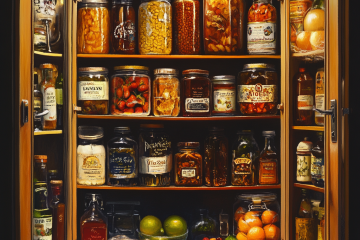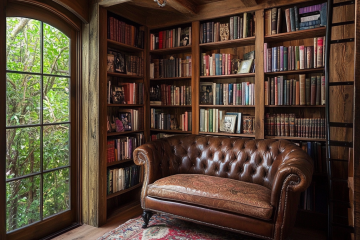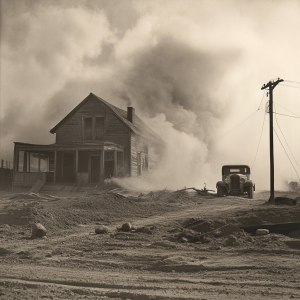
The Dust Bowl
Imagine waking up to find a thin layer of grit coating your skin, your lips cracked and dry. As you open your eyes, you see dust motes dancing in the dim light filtering through the window. This wasn’t an occasional inconvenience – for those living through the Dust Bowl of the 1930s, it was a daily reality.
The relentless drought had turned once-fertile farmland into a barren wasteland. Families watched helplessly as their crops withered and died, leaving nothing but bare, cracked earth. The wind, once a welcome presence on hot summer days, became an enemy. It picked up the loose topsoil and hurled it across the plains, creating massive dust storms that blotted out the sun.
These “black blizzards” could strike with little warning. Children walking home from school might suddenly find themselves engulfed in a swirling vortex of dust, struggling to breathe and see their way home. Mothers frantically stuffed damp rags around windows and doors, trying in vain to keep the insidious dust at bay. But it seeped in through every crack and crevice, coating furniture, contaminating food, and filling lungs.
Breathing became a constant challenge. Many developed “dust pneumonia,” their lungs irritated and inflamed by the constant exposure to fine particles. The elderly and young children were particularly vulnerable, and it wasn’t uncommon for families to lose loved ones to this insidious illness.
Meals were a dreary affair. With crops failed and livestock dying from lack of feed, many families subsisted on meager rations. Those fortunate enough to have a garden guarded it fiercely, but even then, the relentless dust often choked out the struggling plants. People learned to shake out tablecloths before every meal, trying to dislodge as much dust as possible before eating.
Sleep offered little respite. Many took to wearing masks to bed, hoping to filter out some of the dust as they breathed. Others draped wet sheets over their beds, a futile attempt to catch the dust before it reached their pillows. The constant grit in the air made eyes red and irritated, adding to the overall misery.
The psychological toll was immense. Can you imagine the mental fortitude that was required to live through these times? Farmers who had once take
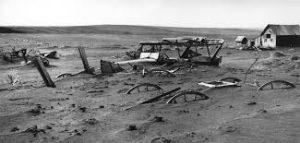
The Dust Bowl 1930’s
n pride in their productivity now watched helplessly as the wind stripped away their topsoil. Debt mounted as crops failed year after year. Many faced the heart-wrenching decision to abandon their homes and land, packing what little they could salvage onto overloaded cars and heading west in search of work and a better life.
Those who stayed faced a daily battle against nature itself. They woke each morning to a layer of dust on their floors, spent hours cleaning only to see their efforts undone in moments by the next gust of wind. The constant struggle wore people down, testing their resilience and faith.
Yet amidst the hardship, there were moments of humanity and hope. Neighbors banded together, sharing what little they had. Communities organized events to lift spirits, with dances and socials offering brief respites from the grinding reality of their situation. Children, resilient as ever, found ways to play, inventing games that incorporated their dusty reality.
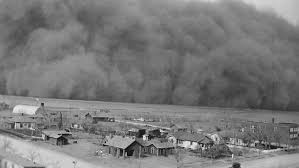
The Dust Bowl
Living through the Dust Bowl was more than just enduring a prolonged drought or occasional dust storm. It was a relentless, daily struggle against an environment that seemed determined to drive people out. Every breath, every meal, every moment was touched by the dust. It reshaped not just the landscape, but the very lives and psyches of those who experienced it, leaving an indelible mark on American history and the collective memory of a generation. How’s your Mental Preparedness efforts?

